Semi-automatic defensive shotguns offer softer recoil and faster follow-up shots compared to a pump-action shotgun. Semi-autos are also more expensive and require more maintenance than the ubiquitous pump gun, and they come in different operating actions — inertia operated and gas operated. In the gas-operated category itself, there are different types of gas-operated shotguns. So we decided to take a look at three semi-automatic shotguns with different operating actions.
The Stoeger M3000 Defender uses a simple inertia-operated action with a two-piece bolt and spring. Your shoulder basically helps cycle an inertia-operated gun. The plus side with an inertia-operated gun is there is less maintenance since there is no gas piston to foul. All the gas from the shot goes down the barrel. The negative side with an inertia-operated gun is there is more felt recoil compared to a gas-operated gun.
The first gas-operated shotgun tested here is a Mossberg 940 Pro Tactical. The Mossberg 940 uses a single gas piston and is designed to run cleaner than the previous Mossberg Model 930. Mossberg says you can easily fire 1500 rounds between cleanings, and from our experience with this 940, that seems about right.
The Radikal SAX2 is a clone of the Benelli M4 and features the ARGO (Auto-Regulating Gas-Operated) system that uses two gas pistons that are self cleaning, which means you can run the Radikal longer than most other gas-operated shotguns. The manual suggested cleaning the shotgun every 250 to 500 rounds. So if the negative aspect of a gas-operated shotgun is maintenance, the plus side is less felt recoil. And in our view, both the Mossberg and Radikal were softer-recoiling guns, while the Stoeger had more felt recoil, but was tolerable even with heavy loads.
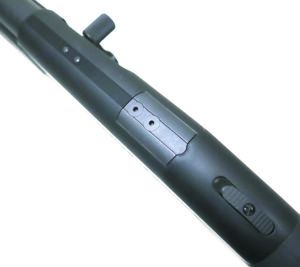
Common features on these three shotguns are 18.5-inch barrels, manual safeties, and polymer stocks. The Stoeger has a fixed choke, while the Mossberg and Radikal feature choke tubes. We like choke tubes because they allow the user to fine-tune the shot pattern. A fixed choke tube, however, keeps the cost of the gun down. The Stoeger and Mossberg both feature standard stock configurations, while the Radikal has a pistol-grip tactical-style stock. The team was split between preferring the standard-style stock or the pistol-grip stock.
We wanted to review these shotguns for use as home-defense guns and vehicle guns. Maneuvering through hallways and bedroom doors (with an empty gun) provides a good sense of how easy it is to deploy when the boogey-man comes. The stocks make these guns long, but we found we could handle them and pie-slice through open doorways fairly easily — not as easy as with a handgun, however. Other criteria we looked at included reliability, ease of loading, shot-pattern consistency, and felt recoil.
For live-fire testing, we set up IPSC/USPSA cardboard targets at 15 yards. These targets are 18 inches wide, and we fired several ammo choices at them, including Remington Premier STS Light Target with 11⁄8 ounces of No. 8 bird shot with a factory muzzle velocity of 1148 fps; No. 4 buckshot with 34 pellets from Federal Vital-Shok, with a factory muzzle velocity of 1250 fps; Hornady Critical Defense 00 buckshot with eight pellets and a factory muzzle velocity of 1600 fps; and Brenneke 1-ounce slugs with factory data stating 1600 fps. To check function, we also loaded a mixed bunch of orphan 12-gauge shells with different shot sizes and muzzle velocities.
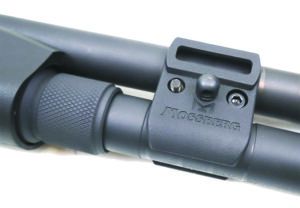
If you have had any experience with semi-automatic shotguns, you know that light loads may not cycle, causing failure to feed (FTF) and failure to eject (FTE) jams. Some shooters gripe about light target loads not cycling, but we test them because we cannot know what might be used in a defense shotgun. We did our due diligence and fired light target loads and found the shotguns didn’t care what we fed them. They all ran exceptionally well. To trip up the shotguns, we also fired them from the hip to see if the lack of a shoulder to recoil on would cause a jam. All ran with no issues when fired from the hip. We ran an excessive amount of shells through these guns not only to test reliability, but also for the sheer fun of shooting these soft-recoiling shotguns. Our biggest takeaway was that the Federal No. 4 Buckshot had a pronounced kick to it, and the shotguns also flung these empties into the next zip code compared to the other shells.
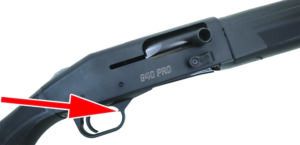
At the end of the extended shooting sessions, we also tested Huntego Cleanshot shells ($10/5 shells, HuntegoLtd.com) to clean the dirty barrel bores. Cleanshot shells are built with squeegees that wipe the bore, and high-density composite felt that scrubs the bore, trapping particles and pulling them out the muzzle. The idea is you fire a Cleanshot shell after shooting your shotgun, and it cleans out the barrel. We found these shells worked, but they weren’t a replacement for a thorough cleaning. The shells did, however, make cleaning the bore easier because they scraped out much of the gunk.
Toting the shotguns to and from the range with a 5.11 42-inch Single Rifle Case ($92; 511Tactical.com) was convenient. In fact, this case has become our go-to case for long-gun reviews. Because all the shotguns had 18.5-inch barrels, they easily fit in the soft padded case. The case has internal padded muzzle and buttstock sleeves and dual retention straps to secure the guns. It also has a top-carry handle and removable shoulder strap and YKK zippers that operate smoothly.
Want to know which semi-auto 12 gauge we’d buy? Read on.
Gun Tests Grade: A (OUR PICK)
$1189
Mossberg is always pushing the envelope on new pump-action or semi-automatic shotguns. Mossberg debuted the 940 series with the JM Pro Competition in 2020 and has since added hunting models and this new Tactical model.
| Action Type | Semi-auto, gas operated |
| Chamber Size | 3.0 in. |
| Overall Length | 37.5 in. |
| Capacity | 7+1 |
| Weight Unloaded | 7.5 lbs. |
| Weight Loaded | 8.2 lbs. |
| Barrel Length | 18.5 in. |
| Finish | Matte blue |
| Choke Tubes | Accu-Choke, Cylinder |
| Buttstock | Textured polymer, adjustable |
| Buttstock Length Of Pull | 12.5 to 14.25 in. |
| Fore End | Textured polymer w/M-LOK rail |
| Sights | Front fiber optic, optics ready |
| Trigger Pull Weight | 5.7 lbs. |
| Safety | Manual trigger block |
| Warranty | 2-year limited |
| Telephone | (203) 230-5300 |
| Website | Mossberg.com |
| Made In | U.S. |
The 940 series evolved from the 930 series and has a redesigned gas-operating system that features a new piston and aluminum-sleeve buffer tube that rides over the magazine tube so that the gun runs cleaner and more reliably. The gas piston, magazine tube, hammer, and sear all have a nickel-boron coating to assist cycling. Also different in the 940’s mechanism design is the recoil spring slides over the magazine tube. Many auto shotguns place the recoil spring inside the stock.
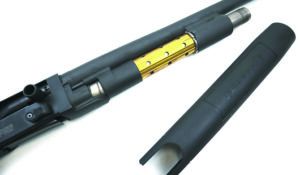
Elsewhere, Mossberg cut the receiver to allow for mounting a red-dot reflex sight. The cut matches the footprint of a Shield RSMc micro-dot reflex sight or sights with a similar footprint, such as a Holosun K series, Leupold Delta Point Pro, JP Enterprises JPoint, and others. The 940 comes with a super-sized bolt handle and bolt-release button that makes operating the shotgun easier with or without gloves. The loading gate is beveled and enlarged so there are no sharp edges or thumb pinches when pushing shells into the magazine tube. In fact, 3-Gun shooters can load multiple shells at once with ease. The manual safety falls under the thumb of a left- or right-handed shooter, which is intuitive, in our book. At the kicking end, there is a beefy recoil pad, and the length of pull can be adjusted via a series of spacers. Drop and cast is also adjustable via shims. An adjustable fixed stock sounds like an oxymoron, but these adjustable stocks are becoming a standard feature on shotguns, and we appreciate this type of stock.
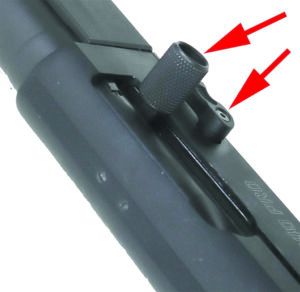
The stock is plain polymer with texture applied to the gripping areas. Sling studs are installed on the buttstock, and the barrel clamp, which also has a bit of M-LOK rail on each side, allows users to mount a tactical light or laser.
The barrel is plain and belled at the muzzle to take Accu-Choke choke tubes. The Mossberg comes with one choke tube, and we thought it was cheap of Mossberg to only include one tube since the price of the 940 semi-auto is twice that of the other shotguns from Stoeger and Radikal.
The 940 wears a red-fiber-optic front sight that is simple and fast to use. It’s this way because many 3-Gun shooters prefer a plain bead to a ghost ring rear sight and post front. In use, the fiber optic bead is very fast on target but lacks aiming precision of rifle-style sights.
The extended magazine tube holds seven shells plus one in the chamber. You can also ghost load (have one shell on the lifter between the chamber and the magazine) the 940 for a total of nine rounds. Fully loaded, the 940 weighs more than 8 pounds and is muzzle heavy. While the balance may be forward, the weight helps dampen recoil. The weight and overall length of only 37.5 inches make the 940 fairly quick handling, we found.
To load the 940, lock back the bolt, drop a shell in the chamber, and press the bolt-release button to allow the bolt to run forward. Then push shells into the magazine tube. We also ghost-loaded a shell in the 940, and it ran without a hitch.
Fired in the 940, the Remington No. 8 bird shot spilled over the edges of our 18-inch-wide target, but the Federal No. 4 buckshot produced a 7.5-inch group on average, and the Hornady Critical Defense produced a 3-inch average group. Throwing slugs down the barrel, we did not notice the recoil. Our average slug group measured 2.5 inches.
Our Team Said: The 940 is soft recoiling and easy to operate due to the oversized controls and beveled loading port. It had the best trigger pull of all the shotguns tested. A Mossberg costing more than a thousand dollars seems contradictory because Mossberg is known for producing affordable shotguns, yet we like the 940, and in our opinion, it would make a good home-defense gun. If money is no object, it’s Our Pick.
| Federal Vital Shok | Mossberg | SDS Radikal | Stoeger |
| 2.75-in. No. 4 Buckshot | 940 Pro Tactical | SAX2 | M3000 Defense |
| Average Pattern Size | 7.5 in. | 8.0 in. | 9.0 in. |
| Remington STS Light Target | Mossberg | SDS Radikal | Stoeger |
| 2.75-in. No. 8 Shot | 940 Pro Tactical | SAX2 | M3000 Defense |
| Average Pattern Size | 19.0 in. | 18.0 in. | 19.0 in. |
| Hornady Critical Defense | Mossberg | SDS Radikal | Stoeger |
| 2.75-in. 00 Buckshot | 940 Pro Tactical | SAX2 | M3000 Defense |
| Average Pattern Size | 3.0 in. | 3.0 in. | 2.0 in. |
| Brenneke K.O. | Mossberg | SDS Radikal | Stoeger |
| 2.75-in. 1-oz. Slug | 940 Pro Tactical | SAX2 | M3000 Defense |
| Average Pattern Size | 2.5 in. | 2.0 in. | 3.0 in. |


























